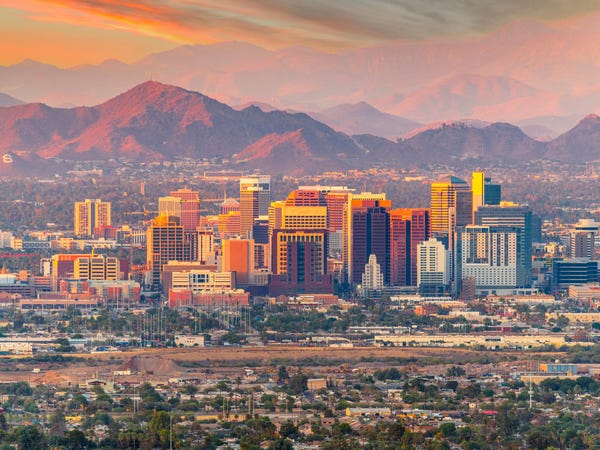The following column by Danny Seiden originally appeared on foreignpolicy.com on August 15, 2023. Seiden was responding to this column that appeared in the same publication on August 4.
A recent article published in Foreign Policy arguing against corporate investment in Arizona completely misses the mark. Not only does it misstate the facts, but it also dismisses Arizona’s decades of success advancing sustainable growth while ignoring the many climate challenges present in other states.
Arizona is one of the leading states fueling the United States’ advanced manufacturing resurgence. Many of the world’s most innovative companies have chosen to invest here, including Intel, TSMC, LG Energy Solution, Virgin Galactic, Proctor and Gamble, American Battery Factory, Northrop Grumman, Insight Enterprises, Benchmark Electronics, Leonardo, EMD Electronics, Gulfstream Aerospace, and Fujifilm Electronic Materials. All of these firms have expanded their operations in Arizona—and that’s just in the last two years.
These companies value Arizona’s many competitive advantages, such as our rapidly growing skilled labor force, top-notch universities and community colleges, modern transportation infrastructure, and a favorable low-cost business environment. They’re also betting on Arizona’s long-term vitality, and they’re right to do so.
For decades, Arizona has embraced a forward-thinking approach to conserving its most precious resource—water—and securing its long-term future. In fact, many of the world-class conservation efforts being implemented elsewhere as emergency measures were established in Arizona decades ago as a way of life.
Arizona’s landmark 1980 Groundwater Management Act restricted irrigation on new farmland, established “active management areas” covering the state’s fastest-growing metropolitan areas, and implemented a 100-year assured water supply requirement for builders. It took over three decades for California to follow suit and pass its own groundwater management act.
While the authors sought to exploit Arizona’s proactive water planning as a vulnerability, a closer examination of the facts reveals this area to be a strength, not a weakness.
For example, in June, the Arizona Department of Water Resources released its latest 100-year groundwater model for the Phoenix area. The model, and Arizona’s related Assured Water Supply program, represent national best practices for water stewardship, guaranteeing for Arizona homeowners and businesses that their water exists far into the future.
The latest Phoenix groundwater model shows the high-growth area meets 96 percent of groundwater demands for the coming century—through 2121—a testament to the state’s far-sighted stewardship. Making up the 4 percent deficit is achievable when you consider Arizona uses less water today than in 1957, with more than six times the population and 22 times the economy as measured by gross domestic income growth.
Contrary to what the authors wrote, the new model has not frozen new housing construction in the Phoenix area. In fact, the region has more than 80,000 new houses in the pipeline for which water certificates have been issued. Likewise, 15 entities in the Phoenix region, including the largest cities and towns, have already obtained a designation of assured water supply and are not impacted by the update.
Ongoing efforts to increase efficiency, conservation, reuse, and augmentation will lead to even greater water stewardship results.
Arizona’s industry leaders are key partners in water conservation efforts. Intel’s Arizona operations, which include four fabs and two more under construction, have been recognized nationally for water stewardship, conserving more than 3 billion gallons last year. Intel’s 12-acre onsite water reclamation facility at its Ocotillo campus in Chandler, Arizona, treats more than 9 million gallons of water a day, enabling its four fabs and counting to reuse water constantly within its systems.
Likewise, TSMC, which announced a $40 billion investment to build two high-tech fabs in the state, is in the planning stage of building an onsite water reclamation plant, enabling its Arizona operations to achieve near-zero liquid discharge.
While attacking Arizona as uniquely vulnerable to climate change, the authors conveniently ignored challenges being experienced elsewhere in the United States. Take, for example, extreme weather events.
According to Climate Central, weather-related power outages have increased dramatically over the past two decades, caused primarily by winter blizzards, tropical cyclones, and severe weather. States in the Southeast, Midwest, and Northeast experienced the greatest number of outages caused by extreme weather events.
These outages carry tremendous costs for businesses and residents alike. An energy industry report found that, for the years 2020 and 2021, extreme storms and subsequent power outages in Michigan resulted in a nearly $5 billion economic loss. Similarly, when winter storms knocked out Texas’s energy grid in 2021, the local utility cut electricity to local semiconductor factories. As a result, companies like NXP, Infineon, and Samsung experienced forced factory shutdowns lasting weeks, costing tens of millions of dollars.
Arizona’s energy grid, in contrast, is ranked among the top two most reliable in the country by CNBC. The state is one of only nine mainland U.S. states with fewer than five weather-related major power outages from 2000 to 2021, demonstrating its resilient energy grid as well as a relative lack of natural disasters affecting other regions.
The authors sought to disparage Arizona on another point: its workforce. In doing so, they offered up other states as suggested alternatives, namely Illinois, Michigan, Ohio, and New York. This baffling argument defies logic—and data. Arizona is a nationally recognized skilled talent super-magnet. The other states? Not so much.
To begin with, Maricopa County, which encompasses the Phoenix area and is home to roughly 4.5 million people, is ranked the No. 1 county for talent attraction by Lightcast, and has held that spot five out of the last six years. The county added the most new residents in the country between July 1, 2021 and July 1, 2022.
Statewide, between 2020 and 2022, Arizona grew at a rate of 2.9 percent and added 207,690 residents. Illinois, Michigan, Ohio, and New York? They all lost people, including in the hundreds of thousands for Illinois and New York.
Arizona’s population gains are driven by young, educated workers. According to CBRE, between 2016 and 2021, the Phoenix area saw 32 percent growth in residents in their 30s with college degrees, the third-best in North America, and 28 percent growth of residents in their 20s with a college degree, the fifth-best in North America. Statewide, between 2017 and 2021, Arizona saw the fourth-highest percentage increase in educational attainment, a metric that measures the number of adults over 25 with at least an associate degree.
Comparing semiconductor workforces, the combined total semiconductor workforces of New York, Ohio, Michigan, and Illinois barely amount to half of Arizona’s rapidly growing industry.
It is true that TSMC recently announced a six-month delay to production in Phoenix. Moderate delays are neither unusual nor unexpected for industry projects of this scale, especially when considering TSMC’s Phoenix fabs will house North America’s most advanced semiconductor technology in mass production, the kind that isn’t housed anywhere else in the United States.
Reasons for this delay have been grossly misconstrued by the authors. As communicated by TSMC, the company’s highly advanced Arizona operations already support more than 2,200 employees on-site as well as over 12,000 local construction workers. The need for additional expertise relates narrowly to specialized equipment installers for TSMC’s 3- and 4-nanometer fabrication machines, which are mainly in use in only one place in the world: Taiwan. The primary job of these Taiwan-based installers will be to train, coach, and mentor the workforce on the ground, not replace U.S. workers.
To extend this isolated labor issue to broadly attack Arizona’s nation-leading talent attraction record is inaccurate and unfair in the extreme.
When comparing actual data and facts, it’s clear that Arizona still offers a superior investment environment. That would explain why so many of the world’s leading technology companies are choosing it as a location to expand.
Danny Seiden is the president and CEO of the Arizona Chamber of Commerce & Industry
















Add comment